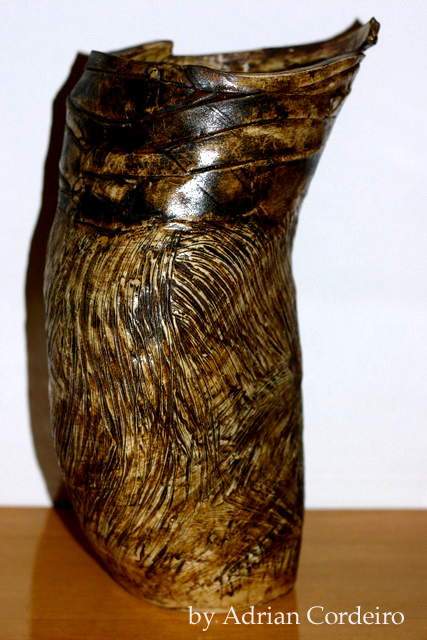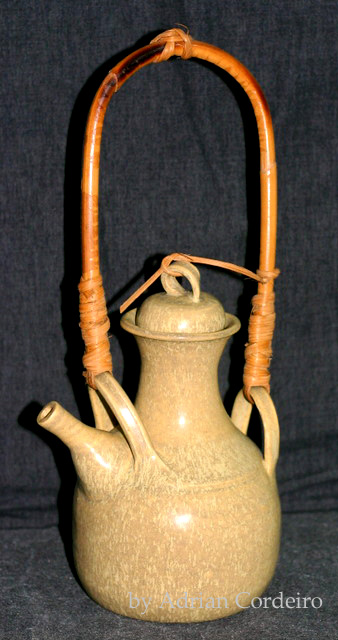
Stoneware Pot, free form. Size: H 35cm X W 18cm. Glaze: Transparent with oxides staining. Method: Coil
The piece is asymmetrical with a slight twist and
change in direction from foot to rim. I am more
interested in form and texture for visual and tactile
stimulation. With its variation in textures,
a blind person should be able to appreciate this piece.– Adrian Cordeiro
When I was about five years old, my father was a teacher at St. Patrick’s Secondary School in Singapore, an all boy’s Catholic school founded in 1933. Every Saturday I would be there and end up bouncing around in the school’s Art Room, which was separated in two sections, a section with tables for the students and a chalk board, and a lower section with pottery wheels, kilns and working space for larger craft projects.
I still remember the smell of settled chalk dust in the after school hours and the smell of soaking clay that was allowed to stand in water, its remnants to be collected and reused for another pottery project.
More than his exhibitions, I remember watching him when he worked. He worked with various materials, from metal, marble carvings, oil painting, to pottery and I know now he has gone into glass art which he works on with my mother.

An ewer, thrown on the wheel, with bamboo handle and lid, by Adrian Cordeiro.
Back when I was five years old, one particular metal sculpture I remember stood over 10 ft tall (at least it felt like that when I was five). It was a crucifix of Christ. At that age I was more intimidated by the twisted metal than perhaps a full understanding of the finished piece. But what I do remember, is how my father worked relentlessly on that project for a very long time. When I got bored of running in the school field, I would pop into the Art Room and see him welding. I would then run outside again. And back again in, and he would still be there intently welding. Consistently, without giving up, he molded the metal to what he had in his mind, making his ideas concrete.
Putting pieces of history, of growing up and of what is current, I can see that what I know about my father, as a daughter, comes through loud and clear in his art. Most of his pottery works are often boldly decorated in thick lines, glazed in earthy tones and weigh heavy in the hand.
I figure it is the same with most art, where you can really understand any artist through their works by observation and interpretation. That insight makes walking through a museum very much like meeting a lot of quite interesting people. So much so that a late visit at the Tate Gallery of Modern Art in London made me strangely enough, very upset without me really at first, understanding why.

Thrown pot with human figures sitting on the rim.
A humanist at heart, with strong concerns for the family and the welfare and well being of others is how I would describe him through his art. After all, a pot is a container and what is a family if not something that ideally should be round and welcoming, with a private space you can call your own?
When I left Singapore for Sweden I asked my father if I could have some of his pottery work with me. I was more than happy when he obliged and handed over three pieces which now very nicely decorate my living room.